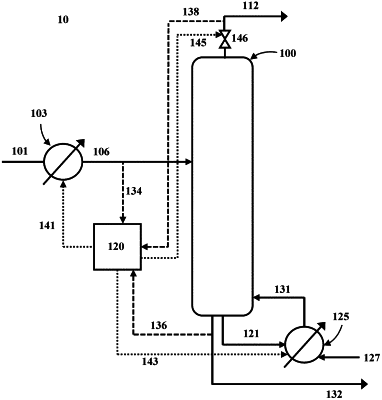| CPC C10G 7/12 (2013.01) [G05B 13/048 (2013.01); C10G 2300/104 (2013.01); C10G 2300/1044 (2013.01); C10G 2300/301 (2013.01)] | 7 Claims |

|
1. A process for operating a refinery distillation unit, comprising:
(a) directing a feed stream comprising a mixture of hydrocarbons, the hydrocarbons having a boiling point that is in the range from 45° C. to 85° C. (at 1 atm) into a distillation unit that separates hydrocarbons according to their boiling point to produce at least a first fraction that leaves the distillation unit via first outlet and a second fraction that leaves the distillation unit via second outlet,
wherein the first fraction has an average boiling point (at 1 atm) that is less than the average boiling point (at 1 atm) of the second fraction,
wherein the first fraction comprises at least a first chemical that comprises a first monetary value (per unit) and the second fraction comprises at least a second chemical comprising a second monetary value (per unit),
wherein the first chemical does not completely segregate into the first fraction and the monetary value of the percentage (mol %) of the first chemical that does not segregate into the first fraction is zero,
wherein the second chemical does not completely segregate into the second fraction and the monetary value of the percentage (mol %) of the second chemical that does not segregate into the second fraction is zero;
(b) separating the feed stream in the distillation unit to produce the first fraction and the second fraction;
(c) determining the percentage (mol %) of the first chemical that leaves the distillation unit in the first fraction and the percentage (mol %) of the second chemical that leaves the distillation unit in the second fraction;
(d) calculating a total profit obtained from the separating by multiplying a first chemical price consisting of the monetary value (per unit) of the first chemical by the percentage (mol %) of the first chemical in the first fraction, then adding to this the product of a second chemical price consisting of the monetary value (per unit) of the second chemical multiplied by the percentage (mol %) of the second chemical in the second fraction,
wherein the first chemical price is selected from one of: 1) a first chemical commercial price and 2) a first product commercial price multiplied by the conversion efficiency from the first chemical to the first product, wherein the first product is derived from the first chemical;
wherein the second chemical price is selected from one of: 1) a second chemical commercial price and 2) a second product commercial price multiplied by the conversion efficiency from the second chemical to the second product, wherein the second product is derived from the second chemical;
(e) intermittently performing the calculating of (d) with an algorithm to find a solution cut point temperature that produces a maximum total profit from the separating at the time the calculating is performed, wherein the solution cut point temperature corresponds to known operating settings for the distillation unit, wherein the first chemical price and the second chemical price are variable and can change between iterations of the calculating
(f) adjusting the known operating settings of (e) to the distillation unit, wherein the adjusting comprises altering one or more operating parameters to change the distillation unit cut point temperature to the solution cut point temperature,
wherein the operating parameters are selected from one or more of: the temperature of the heated feed stream entering the distillation unit, quantity of heat input to the reboiler and flow rate of the light fraction leaving the distillation unit,
wherein the adjusting alters at least one of: the percentage of the first chemical that exits the distillation unit in the first fraction and the percentage (mol %) of the second chemical that exits the distillation unit in the second fraction.
|